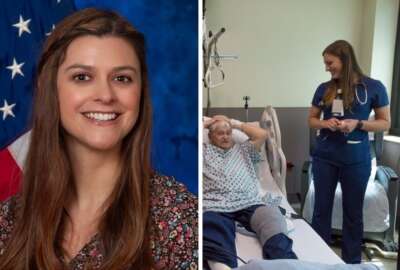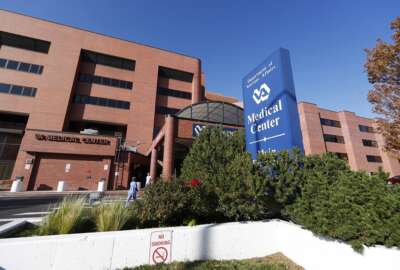

The Million Veteran Program of the Veterans Affairs Department does not quite have a million participants. But it did recently reach 900,000.
Best listening experience is on Chrome, Firefox or Safari. Subscribe to Federal Drive’s daily audio interviews on Apple Podcasts or PodcastOne.
The Million Veteran Program of the Veterans Affairs Department does not quite have a million participants. Not quite yet. But it did recently reach 900,000, when a retired reservist and purple heart recipient joined up. For an update on what VA calls its largest research project ever, the Federal Drive with Tom Temin spoke to program director Sumitra Muralidhar.
Interview transcript:
Tom Temin: So 900,000 sounds like a pretty good milestone to me. But are you still driving toward literally a million veterans to be in this program?
Sumitra Muralidhar: Oh, absolutely. In fact, we know we’re looking forward to getting to the million and even going beyond, we’re not going to stop when we get to the million.
Tom Temin: So this is the idea of big data driven medicine. Is that the fundamental theory behind this program?
Sumitra Muralidhar: Yes, absolutely. So to really, you know, get to the bottom of how our genetics, our environment, our lifestyle, how all these different factors interplay and influence our health and illness, we need large numbers, it is a numbers game, as I always call it. We need large numbers of people with a particular condition and an even larger without it so you can compare and see what contributions each of these factors are making, in terms of causing risk or a specific illness.
Tom Temin: It sounds as if there are a range of treatments available for a given malady or situation that a person has. But it may not be within the range of knowledge of a given practitioner for a given patient to know what is the exact best thing in that particular situation. So analytics can maybe help determine that, is that is one of the foundational ideas here?
Sumitra Muralidhar: Yes, that is one major aspect of it. It’s called pharmacogenomics and that the way people respond to a medication is in part determined by genetics for some of the medications. And so really knowing that you could tailor the treatment to the person, you know, at the right time and at the right dose, sometimes it’s just a matter of varying the dose that that’s best for that person. Again, detail could be determined by genetics.
Tom Temin: And what information then comes from each participant, the 900,000, and eventually a million that you’ll have, what does it need from them to be able to power this type of research?
Sumitra Muralidhar: Great question. So first and foremost, the VA has one of the best, the deepest electronic health records. And that is the treasure, we need their health information from their health record, what diagnosis they’ve had, when, how long, what they’ve been treated for, what their responses have been. So we can see all of that that’s their health record clinical data. Then we collect data from self-reported surveys, you know, a lot of things about what you eat, what your lifestyle is, how much you exercise, do you drink, do you smoke, all of that is not really well documented in the electronic health record. So we obtain all these additional information on lifestyle. And maybe in the case of veterans, even, you know, where they had been deployed, what they might have been exposed to, you know, military exposures, and experience. And that’s the second piece, lifestyle, nutrition, military experience, and so on. The third piece is molecular data, we want to get the genetics and other molecular profiles. And for that we collect a blood sample from our participants. And we do a baseline genetics on everyone who participates. And then we’re diving deeper on subsets of patients to do other kinds of analyses, like proteomics, metabolomics, that’s the goal to keep doing deeper dive into the molecular information. So then we have this very comprehensive data set on a person that you can then look at how they all contribute.
Tom Temin: And some of this data is expository like, you know, this is what I eat for breakfast and lunch and dinner and so on. Some of it is structured data, say from the VISTA system where their records exist. And some of it is whatever form molecular data takes. You must work with IT people to kind of normalize all this and put it all in one place where it’s accessible. Is that a component?
Sumitra Muralidhar: Yes. So we made a decision early on, that we would rather than distribute datasets to researchers, because this is big data and for good reason, because many individual researchers may not even have access to storage and computing of such large data sets. So we want it to bring researchers to the data in a central computing, scientific computing environment, provide all the tools that they need to analyze the data. And give them a role based whatever they’re approved for their research projects. We give them access to the data needed for that project. And and yeah, I’ll just pick up on one of the things you mentioned, so there is a lot of structured data. But there is also a lot of validation and curation of data that needs to happen, both for the molecular data that we generate from the blood samples, and also from even the electronic health record data and the survey data. So there’s a lot of effort that we put in as a core program to curate and make these datasets. uniform and research ready, if you will.
Tom Temin: Got it. We’re speaking with Sumitra Muralidhar. She’s program director of the Million Veteran Program. And what have people been looking at so far? What are some of the research projects you’ve approved, that people are accessing the data and looking at?
Sumitra Muralidhar: So there’s been a wide range of studies. You know, we’ve looked at a number of conditions that we seen in veterans from heart disease, various types of heart, heart failure, cardiovascular disease, cardiometabolic, disease, diabetes, kidney disease, and the whole range of mental health conditions. PTSD, anxiety, depression, we have a project on Gulf War illness. So you name it. This is the reason we want to get to a million and beyond, because then we can really look at a wide range of projects. And then more recently, when the pandemic hit, we were also able to leverage this dataset and look at how host genetics like our DNA, how does that contribute to the way people experience COVID-19, for example, so they’ve been able to make some discoveries in that space as well.
Tom Temin: Interesting. You mentioned diabetes, renal disease, and mental health and heart earlier, these are mature areas for medical research. I mean, there was the Framingham study that went for a million years, and probably half a million I forget the numbers, but landmark study, and of course, renal has been, dialysis is 75 years old. The implication is, though, that there’s still a lot more to learn, even with things we thought we understood?
Sumitra Muralidhar: Yeah, so these very complex diseases, and so we know some about them. But the whole capability to get into the genetics and all this molecular profiles is an evolving technology that’s enabled us to do this. So we can look at more now. And we can discern more, learn more about what causes these illnesses, or how can we better treat them.
Tom Temin: And the researchers that are working on these datasets to try to come up with new answers? Are they mostly from VA? Or do you have academic and maybe even commercial medical system partners also in here?
Sumitra Muralidhar: So currently, they’re largely VA. A VA research program is an intramural research program. But on all our projects, we have academic affiliates collaborating, so you know, so a lot of academic affiliate researchers are already participating in the projects, but access to the data is within the VA system right now. So you have to be a VA investigator to be able to touch the data. But we are looking at, we’re now piloting what we call the VA Data Commons, which is outside the VA firewall, where we will de identify the dataset completely. And so federal researchers from other federal agencies and academic researchers can access it more directly.
Tom Temin: And as the data base gets larger, 500,000 900,000 a million. Are you able to discern whether there’s a point at which there’s no more return on adding more data in there? Or could it be 2 million or 10 million? And I guess the follow up question would be, as more women come in to the veterans ranks, that must have a big effect on what it is you’re able to discern?
Sumitra Muralidhar: Absolutely. Great questions. You know, the first one you asked, I don’t know if they’ll ever be a limit, I think we will always evolve new analytic methods to analyze, you know, that’s also evolving the way people analyze large datasets, and maybe even be compared with atmospheric data or, you know, other large global data that exists, we are still not quite there yet. So I think we will continue to evolve and learn more as we get more and more data. The second question is a great question. Yes. So roughly 10% or so a little less than that, 9% of our participants are women. And we did actually launch a women’s campaign last year to to increase the number of women. And we will continue to do that as we go forward. Because we do want to increase that population representation within the Million Veteran Program cohort.
Tom Temin: And this has been going some time. So it seems like successive secretaries, successive leadership at VA really sees the value in this it sounds like.
Sumitra Muralidhar: Yes. Thank you for asking that question. I’m really very grateful that we have been able to sustain and not just sustain but really have this program advanced where it has. Under the leadership, all the leaders of the agency have been very supportive.
Eric White: Sumitra Muralidhar is program director of the Million Veteran Program in the office of R&D at the Veterans Health Administration.
Copyright © 2025 Federal News Network. All rights reserved. This website is not intended for users located within the European Economic Area.
Tom Temin is host of the Federal Drive and has been providing insight on federal technology and management issues for more than 30 years.
Follow @tteminWFED




